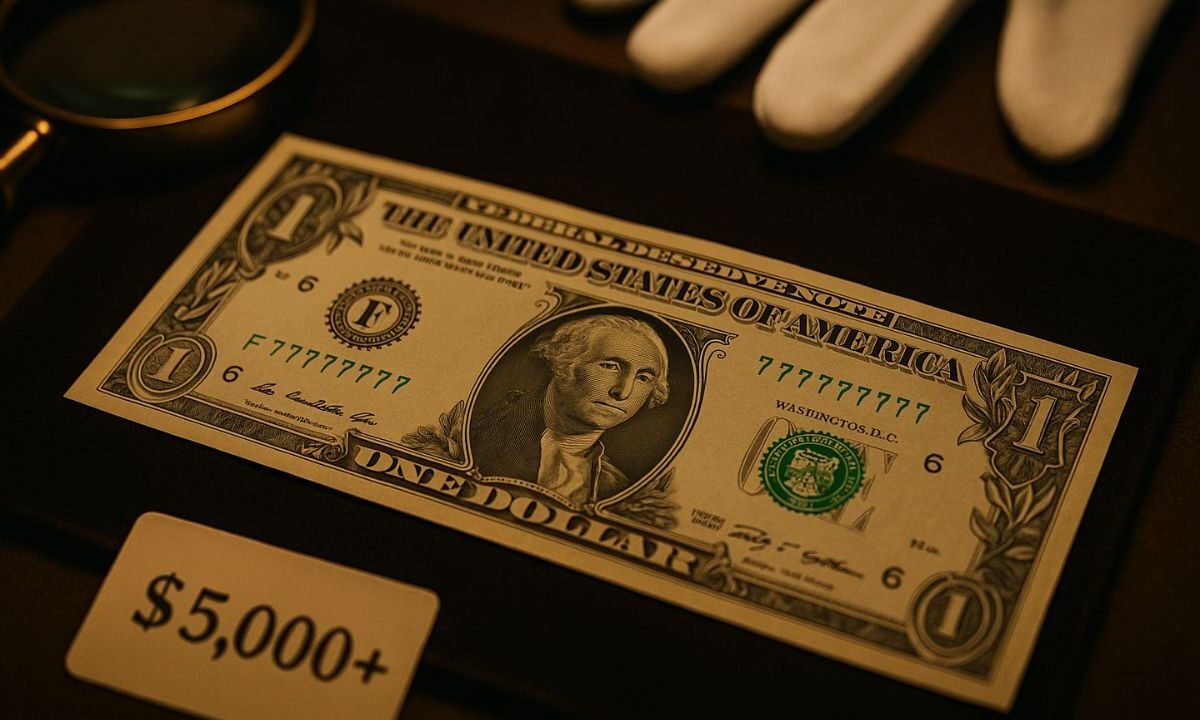Did you know that your $1 bill could be worth thousands of dollars? Many people are discovering that certain fancy serial numbers make even ordinary bills highly collectible.
Some of these bills have sold for over $5,000, depending on their pattern and condition.
Collectors love these special serial numbers because they’re rare, visually unique, and often tell a story through their pattern. Let’s understand what makes them valuable, how to spot them, and how much they could be worth.
What Are Fancy Serial Numbers?
Every U.S. bill has an eight-digit serial number printed twice on the front. Usually, these numbers don’t mean much — but when they form unique or symmetrical patterns, collectors consider them “fancy serial numbers.”
These bills stand out because they show mathematical or repeating patterns that are statistically uncommon. The rarer the pattern, the higher the value.
1. Common Fancy Serial Types
- Solid Numbers: All digits are the same (example: 77777777)
- Ladder Numbers: Digits appear in perfect order (example: 12345678 or 87654321)
- Radar Numbers: The same forward and backward (example: 10000001)
- Low Numbers: Starting with several zeros (example: 00000012)
- Star Notes: Have a star symbol ★ replacing a letter, used when a note is reprinted
Value of Fancy Serial Number $1 Bills
Collectors are willing to pay large sums for these special bills, especially when they are in uncirculated or mint condition. Below is an overview of their approximate market values:
| Serial Number Type | Example | Estimated Value | Reason for Value |
|---|---|---|---|
| Solid Number | 77777777 | Up to $5,000+ | Extremely rare pattern, visually striking |
| Low Number | 00000001 | Around $10,000–$15,000+ | First bills from a print run are highly collectible |
| Ladder Number | 12345678 | $500–$3,000+ | Perfect sequential digits are rare |
| Radar Number | 01122110 | $100–$1,000 | Symmetrical and easy to recognize |
| Star Note | F12345678★ | $200–$5,000+ | Replacement bills printed in small runs |
Keep in mind that the condition of the bill plays a massive role in its final price. Even a rare serial number can lose value if the bill is folded, torn, or written on.
How to Check If Your $1 Bill Is Valuable
Finding out if your dollar is special is easy. Follow these steps:
- Look at the serial number on the front of the bill.
- Check for patterns like identical digits, sequential order, or palindromes.
- Notice any star symbol (★) after the serial number—it may be a “star note.”
- Inspect the condition. A crisp, clean, uncirculated note will always fetch higher prices.
- Compare online using free “fancy serial number checkers” or visit a local currency dealer.
Why Collectors Pay Thousands
Collectors value these bills for three main reasons:
- Rarity: The probability of getting a solid or ladder number is extremely low (less than 1 in 10 million).
- Aesthetic Appeal: Perfectly patterned numbers are visually satisfying and stand out.
- Historical Interest: Some star notes or misprints represent limited runs from specific Federal Reserve Banks, making them desirable among numismatists.
Even though it’s just paper money, these rare bills combine mathematics, design, and history, creating emotional and financial value for collectors worldwide.
Tips for Selling a Fancy Serial Number Bill
- Keep it safe in a protective sleeve or holder.
- Avoid folding or damaging it.
- Get it appraised by a professional currency dealer.
- List it at auctions or collector marketplaces for maximum visibility.
- Document the bill’s condition with clear, high-resolution photos before selling.
That $1 bill in your wallet could be worth much more than you think.
Fancy serial numbers such as 12345678, 77777777, or 00000001 are incredibly rare and can sell for $5,000 or more to collectors. By checking your bills carefully, you might just uncover a hidden treasure sitting in your pocket.
FAQs
Are all star notes valuable?
Not all star notes are worth big money, but ones printed in small batches or with special serial patterns can be highly valuable.
Can used or folded $1 bills still be worth something?
Yes, but condition affects price. A crisp, uncirculated bill will always sell for more than a worn one.
How can I know if my bill’s serial number is rare?
You can manually check for patterns like repeated digits, ladders, or palindromes. There are also online serial number checkers to help estimate rarity.

